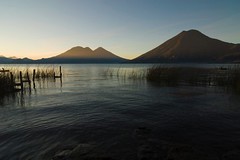
View from the beach
We have now been at Lake Atitlan for over a week. This is a high altitude lake in the mountains of Southern Guatemala. Mountains, including three extinct(?) volcanoes ring the huge lake. Dotted around its shores are numerous villages and towns occupied by Mayans. Three different tribes live around the lake, including the K'ichee' who had lived at Utatlan when the Spanish arrived in the region. The lakeside locations and mountain backdrops gives the impression of each village being an island as most transport is by lake lanchas. There is a lakeside road around three sides but boating it is more fun.

Fishing the Lake
We have been partly relaxing on the beach and partly working on UK contracts while here. We have chosen San Marcos to stay because it is one of the smallest and quietest of the villages. Apart from the main road and a few side streets, most of the tourist accommodations are in a wooded area only accessible by footpaths which gives a nicer, slower pace to life. The village mostly attracts tourists to yoga, meditation courses, holistic therapies and generally chill-out. We have not been to any courses or classes yet, and may not, despite there being a tempting all-day course on impriving your eyesight enough to get rid of glasses. John Hegley would be enraged. Instead we visited one of the larger towns that day - Santiago. There was a very large and purple market in the town. People in each village who where traditional Mayan clothes tend to have their own colours and designs. Santiago women where purples huipeles (blouses) so most people and a lot of clothes stalls were purple.
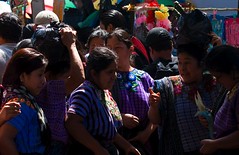
Purple People
Our main interest for visiting Santiago was to go to the shrine of Saint Maximon. He's a strange one. Sort of a patron saint of sinners and groups marginilised in society. He's popular with prostitutes and gays along with lots of other people hoping he can help them. His effigy is hosted by a different family each year and pilgrims give offerings of alcohol and tobacco. Now, there's more to this than simply the giving of vices, I think, because in much traditional Mayan ceremonies tobacco and alcohol are used to invoke and communicate with spirits.
We were led to the shrine by one of the many young boys who guide you for a couple of quetzals. The shrine is currently a dark, somewhat shabby, room with coloured streamers and plastic aubergines hanging from the ceiling. Christ lying prone in a funeral cask lines one wall. The room is lit by candles and a dim fluorescent light. Inside waits Maximon, a wooden carved head bedecked with two fedoras, numerous ties, a jacket and traditional Santiago three-quarter length trousers. His two attendants, a man and a woman site beside him.
We were fortunate to witness a woman coming to have her knees healed. She was asked by the woman to sit in front of Maximon, give a monetary offering, wear one of his hats and a jacket. The female attendant started preying in Spanish to Christ then changed to Mayan while the man alternately placed cigarettes and alcohol in the saint's open mouth. The woman guide or shaman chewed up a cigar, mixed it with saliva in a cup then filled her mouth with the mixture which she spat and rubbed on the pilgrim's knees and shoulders. She then returned to Spanish to prey to Christ and the pilgrim left. We hope her knees get better.
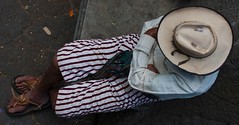
Siesta Time
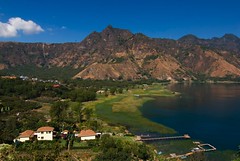
View over San Juan
We have also gone on a couple of lakeside walks. On one I walked the three hour hike from San Pedro to San Marcos via San Juan and San Puablo. From San Juan it was right on the lake beach until the posh foreigners houses near San Marcos where I cut through a coffee finca. Most of the shore above the beach is filled with small vegetable gardens growing onions (San Puablo’s speciality), carrots, salads, cabbages and herbs. Little gardens are terraced into the gentle slope looking a lot like British allotments but with more sun. The fine sandy soil and easily pumped lake water are perfect for onions and carrots. I talked to lots of gardeners along the route who were all interested to know where I was from. Not many people walk the route following guide book warnings of armed robberies on the quiet roads. I think the danger along the lakeside is minimal and it seems a shame few people get the opportunity to talk to these friendly and welcoming people.
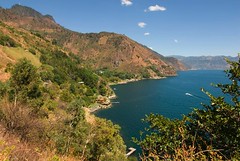
Path to Jaibalito
Our other walk was from San Marco to Jaibalito, in the opposite direction to San Pedro. After the initial section along a quiet road, the rest mostly followed along a mountain path through woods with great views over the lake. The temperature, vegetation, smells and views were very reminiscent of the Aegean! Saw an interesting collapsing building on the way which suggests someone with problems with builders! Jaibalito is another beautiful, quiet little village where we discovered a fantastic European-owned restaurant and hostel called Posada Jaibalto in time for lunch. Not only where the prices incredibly cheap, but the food was delicious and the salads were fresh-picked from the garden.
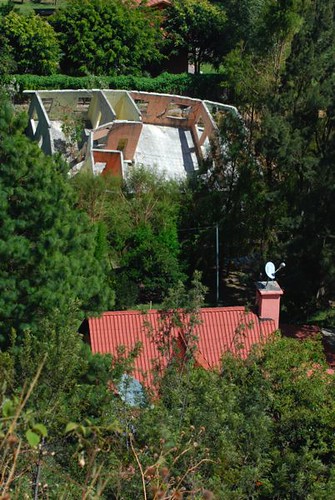
Oops!
Getting There
It is easy to get to Lake Atitlan from nearby towns such as Antigua and Chichicastenango by ordinary 'chicken' bus. From either direction change at Los Encuentros for the bus to Solola which stops at the central park. The bus to Pana leaves from the park, on a Pana sign-posted road diagonally opposite the Los Encuentros drop-off. From Pana you can get lanchas to all the other lakeside villages.
Accommodation in San Marcos
We started off at the budget Unicornia hostel which has good, basic cabanas around a yard and garden, a shared kitchen, clean toilets and a hot shower. The kitchen can get crowded at times and the hostel is very popular so often fully occupied. It is a fantastic place to meet people but can feel a little crowded at times. It is run by a great Guatemalan guy called Chus though he is planning to sell in the next year or so.
After a few nights we moved to Giardino, simply because it had flat space for yoga along, was quieter and set in nicer wooded gardens, had a larger room and, with only four rooms and a large kitchen, it meant making meals was much easier. The cleaning isn't to the same standard as Unicornio and it has taken a lot of requests to get them to do something about a blocked toilet and kitchen sink. The impression is of a place where the owner isn't really investing in maintenance and the hostel is starting to look run-down.



No comments:
Post a Comment